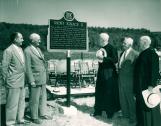1
Arising from meetings in 1949-1950 the provincial government established an historical advisory committee to help ensure the preservation of , and to promote, the province's archaeological and historic sites. In 1953 the Archaeological and Historic Sites Protection Act was enacted, resulting in among other things the creation of the Archaeological and Historic Sites Board of Ontario on which Wilf sat. The Board accomplished a great many things including the creation of the distinctive blue and gold plaques that continue to be erected to commemorate historic places, people and events.
2
Plaque at St. Ignace II site, location of Jesuit Fathers Brebeuf and Lalemont executions, 1649
August 21, 1960
Waubaushene, Ontario, Canada
 Credits:
Credits:
Museum of Ontario Archaeology
3
Wilf continued to be an active member of this Board, from 1956 through to 1975 when the province passed the new Ontario Heritage Act and the Board was re-organized with an expanded mandate to become the Ontario Heritage Foundation. Aside from providing advice, part of Wilf's duties included being the Board's official representative at the plaque unveiling ceremonies and press conferences. The Jury archives at the Museum contain photographs, pamphlets and newspaper articles which confirm Wilf attended over fifty of these unveilings.
4
Wilf at the Discovery Train Ceremony
May 5, 1979
London, Ontario, Canada
 Credits:
Credits:
Museum of Ontario Archaeology
5
Under the provincial legislation it became possible to officially "designate" (protect) certain sites. Of the first eight sites so designated in the 1970s, four were ones that Wilf and Elsie had worked on or strived themselves to protect before the legislation was passed (Lawson site; Forget site; Fort Willow; the Penetanguishene Naval and Military Establishments). Promotion was a major initiative of the Archaeological and Historic Sites Board. With the Ontario Department of Travel and Publicity they produced the popular booklet Historic Ontario. This booklet was circulated in the 1950s to all Ontario schools and tourist locations, creating the need for it to be re-printed several times. One or more of the re- printings featured on the cover a sketch of Sainte-Marie I reconstructed, while the inside pages contained information of several other projects with which Wilf and Elsie were involved (Fanshawe Pioneer Village, Fairfield, Death of Tecumseh, Midland Indian Village, Penetanguishene Naval and Military Establishments, St. Louis site, St. Ignace II site, Schoonertown, Fort Willow, Nine Mile Portage). Today, the Ontario Heritage Foundation continues to administer the historic plaque program and to promote it through publications such as Discover Your Heritage: A Guide to Provincial Plaques in Ontario. It can also be noted that some local historical societies (i.e. Simcoe County Historical Society) have erected their own plaques to commemorate important people and places: a few of those plaques also arose in part due to the various projects undertaken by the Jurys.
 Credits:
Credits: Credits:
Credits: